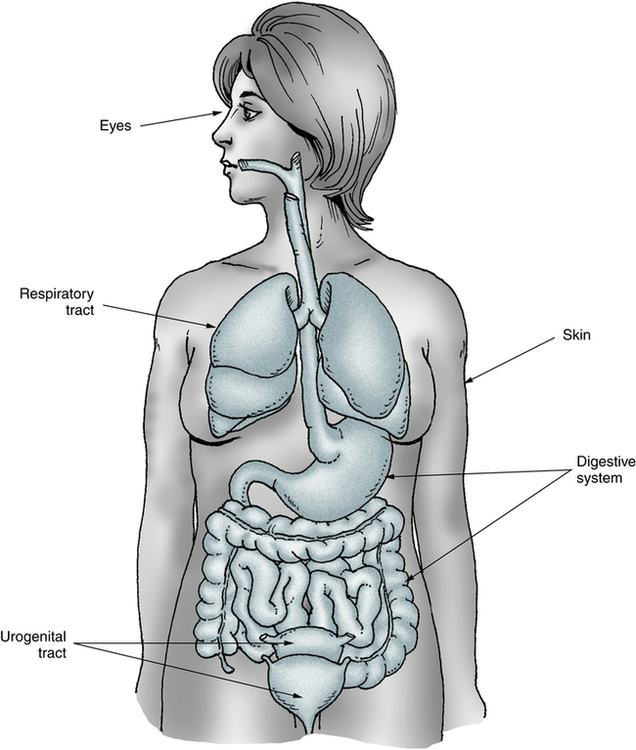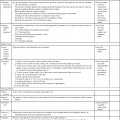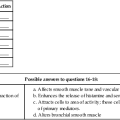At the conclusion of this chapter, the reader should be able to: • Compare an immunogen and an antigen • Explain the functions of the immune system. • Describe the first, second, and third lines of body defense against microbial diseases. • Compare innate and adaptive immunity. • Analyze a case study related to immunity. • Correctly answer case study related multiple choice questions. • Be prepared to participate in a discussion of critical thinking questions. • Describe the characteristics of five mature leukocytes and their immune function. Louis Pasteur is generally considered to be the Father of Immunology. Table 1-1 lists some historic benchmarks in immunology. Table 1-1 Significant Milestones in Immunology Immunology is defined as resistance to disease, specifically infectious disease. Immunology consists of the following: the study of the molecules, cells, organs, and systems responsible for the recognition and disposal of foreign (nonself) material; how body components respond and interact; the desirable and undesirable consequences of immune interactions; and the ways in which the immune system can be advantageously manipulated to protect against or treat disease (Box 1-1). Immunologists in the Western Hemisphere generally exclude from the study of immunology the relationship among cells during embryonic development. The immune system is composed of a large complex set of widely distributed elements, with distinctive characteristics. Specificity and memory are characteristics of lymphocytes (see Chapter 4). Various specific and nonspecific elements of the immune system demonstrate mobility, including T and B lymphocytes, immunoglobulins (antibodies), complement, and hematopoietic cells. Nonself substances range from life-threatening infectious microorganisms to a lifesaving organ transplantation. The desirable consequences of immunity include natural resistance, recovery, and acquired resistance to infectious diseases. A deficiency or dysfunction of the immune system can cause many disorders. Undesirable consequences of immunity include allergy, rejection of a transplanted organ, or an autoimmune disorder, in which the body’s own tissues are attacked as if they were foreign. Over the last decade, a new concept, the danger theory, has challenged the classic self-nonself viewpoint; although popular, it has not been widely accepted by immunologists (see Chapter 4). Before a pathogen can invade the human body, it must overcome the resistance provided by the body’s first line of defense (Fig. 1-1). The first barrier to infection is unbroken skin and mucosal membrane surfaces. These surfaces are essential in forming a physical barrier to many microorganisms because this is where foreign materials usually first contact the host. Keratinization of the upper layer of the skin and the constant renewal of the skin’s epithelial cells, which repairs breaks in the skin, assist in the protective function of skin and mucosal membranes. In addition, the normal flora (microorganisms normally inhabiting the skin and membranes) deter penetration or facilitate elimination of foreign microorganisms from the body.
An Overview of Immunology
History of Immunology
Date
Scientist(s)
Discovery
1798
Jenner
Smallpox vaccination
1862
Haeckel
Phagocytosis
1880-1881
Pasteur
Live, attenuated chicken cholera and anthrax vaccines
1883-1905
Metchnikoff
Cellular theory of immunity through phagocytosis
1885
Pasteur
Therapeutic vaccination
First report of live “attenuated” vaccine for rabies
1890
Von Behring, Kitasata
Humoral theory of immunity proposed
1891
Koch
Demonstration of cutaneous (delayed-type) hypersensitivity
1900
Ehrlich
Antibody formation theory
1902
Portier, Richet
Immediate-hypersensitivity anaphylaxis
1903
Arthus
Arthus reaction of intermediate hypersensitivity
1938
Marrack
Hypothesis of antigen-antibody binding
1944
Hypothesis of allograft rejection
1949
Salk, Sabin
Development of polio vaccine
1951
Reed
Vaccine against yellow fever
1953
Graft-versus-host reaction
1957
Burnet
Clonal selection theory
1957
Interferon
1958-1962
Human leukocyte antigens (HLAs)
1964-1968
T-cell and B-cell cooperation in immune response
1972
Identification of antibody molecule
1975
Köhler
First monoclonal antibodies
1985-1987
Identification of genes for T cell receptor
1986
Monoclonal hepatitis B vaccine
1986
Mosmann
Th1 versus Th2 model of T helper cell function
1996-1998
Identification of toll-like receptors
2001
FOXP3, the gene directing regulatory T cell development
2005
Frazer
Development of human papillomavirus vaccine
What is immunology?
Function of Immunology
Body Defenses: Resistance to Microbial Disease
First Line of Defense

Body fluids, specialized cells, fluids, and resident bacteria (normal biota) allow the respiratory, digestive, urogenital, integumentary, and other systems to defend the body against microbial infection.
![]()
Stay updated, free articles. Join our Telegram channel

Full access? Get Clinical Tree


Oncohema Key
Fastest Oncology & Hematology Insight Engine



